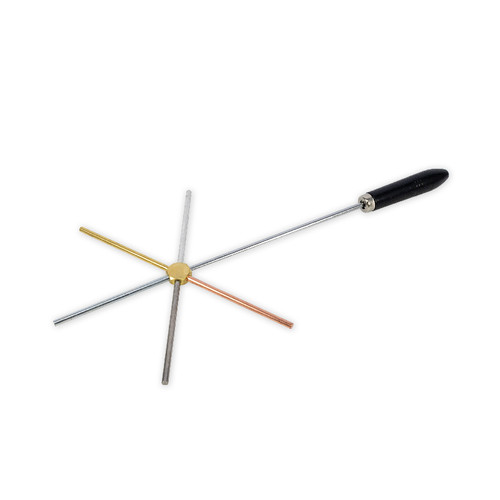Product Description
Comparing the heat conductivity of different metals is one of the well known educational science projects for students in grades 5 to 8 and all others who may study physics or engineering in future.
To perform heat conductivity experiment you need same size rods of all metals which you are planning to compare. Then you need to devise a method to heat up one end of all your metal rods with the same amount of heat to see which one will transfer heat to the other end faster. It is like a race. You must rank your samples based on the speed they transfer heat from slowest to fastest. Heat conductometer is a device prepared for this experiment. It includes solid rods of 5 different common metals including copper, aluminum, nickel, steel (iron) and brass. All metals are attached to a brass disk on the center (the hub). It also has a handle that can be screwed to the side or to the top.
To do the test you place small pieces of wax (usually paraffin wax or bees wax) on the cavity at the end of each rod. Then you heat up the center disk or hub and wait until the heat is distributed evenly to all the rods.
One of the rods will conduct the heat faster than others. Heat will melt the wax and it starts to drip or fall. Make note of the metal that lost the wax or melted the wax first. Continue the heat until other metals loose their wax and make a list of them in the order in which they loose their waxes.
The first metal that lost the wax has the highest heat conductivity. The metal that looses the wax last has the lowest heat conductivity. Record how many second did it take for each metal to loose its wax in a table that must be included in your report.
Save the metal rods or the entire heat conductometer for future experiments.
Repeat your experiment as many times as needed to make sure that you have the most accurate result.
There are three models available, made by different manufacturers. The difference is in the size or location of the wax cavity and the design of the hub.
LABCON: is the basic heat conductometer as shown in the image
P65013: is the same as LABCON above, but it also contains some wax and one page printed instructions.
AS3223: Has a larger hub so that the handle may optionally be screwed to the center of the hub. This model also comes with printed instructions, but no wax.
For all the above models we can include some granular paraffin wax at no charge if you request it in the comment section of your order. Otherwise you can remove a small amount of wax from a candle you may have at home.











